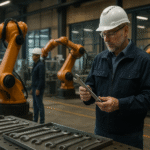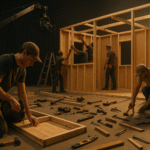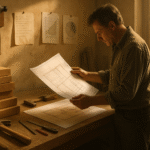When it comes to cutting into tight corners or confined areas, few tools are as handy as the keyhole saw and the jab saw. Both are small, handheld cutting tools designed for precision in difficult spaces — often used where a larger saw simply won’t fit. To the untrained eye, they look nearly identical: slim blades, pointed tips, and ergonomic handles. But their subtle differences can determine whether your cut is clean, efficient, or just plain frustrating. Understanding what sets them apart helps every craftsman and DIYer make cleaner, safer, and smarter cuts.
The keyhole saw, sometimes called a “pad saw” or “compass saw,” is built for precision. Its narrow, tapered blade and fine teeth make it ideal for cutting small holes or intricate shapes in wood, drywall, and soft plastic. The long, pointed tip can be inserted through pre-drilled holes, allowing users to make detailed interior cuts — perfect for fitting pipes, outlets, or vents. Because of its delicate build, a keyhole saw works best on light materials. It’s a favorite among finish carpenters, electricians, and anyone working on fine detailing where control matters more than speed.
The jab saw, on the other hand, is designed for force and speed. True to its name, it’s used by “jabbing” the pointed tip directly into drywall or similar material to start a cut without pre-drilling. The blade is thicker, the teeth more aggressive, and the handle sturdier to handle impact. This makes it ideal for rougher tasks like cutting drywall openings for electrical boxes, plumbing access, or HVAC vents. However, its coarse teeth can tear delicate materials, making it less suited for fine joinery or precise shapes. In other words, the jab saw is built for construction efficiency, while the keyhole saw excels at finishing detail.
Choosing between the two often depends on the material and accuracy required. For small, curved, or delicate work, the keyhole saw’s control is unmatched. For fast, rough, and repeated cuts — especially in drywall or plaster — the jab saw gets the job done quickly. This distinction mirrors the same principle found in Carcass Saw vs Tenon Saw: Understanding the Difference Between Two Precision Tools, where subtle design differences completely change the saw’s ideal use. Knowing when to prioritize accuracy over force is part of what defines real craftsmanship.
Both saws also demand proper maintenance for long-term reliability. Regular cleaning, tooth inspection, and occasional sharpening ensure smooth cuts and safety. As outlined in Five Tool Maintenance Habits Every Maker Should Know in 2025, consistent care not only extends tool life but also improves control during detailed work. For professionals working in tight spaces, a dull blade or misaligned tooth can turn a simple job into a costly repair.
In today’s era of power tools and digital cutting systems, hand saws like these continue to hold their place because of one simple advantage — feedback. They let you feel the material as you cut, making small adjustments that no automated system can replicate. The keyhole and jab saw may seem like modest tools, but they represent an essential balance between precision and practicality. Whether you’re trimming drywall or carving detail into timber, knowing which one to grab is the mark of an experienced craftsman.









